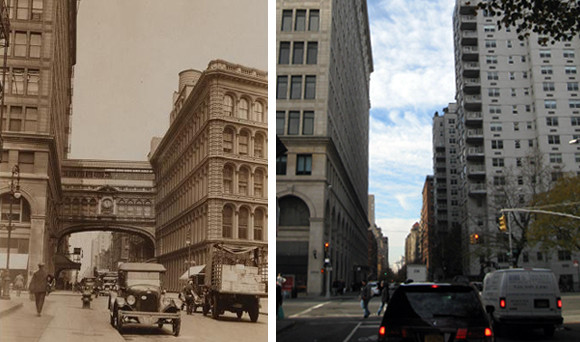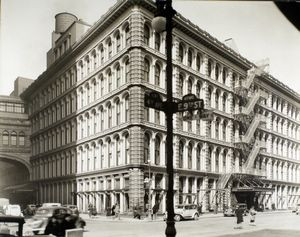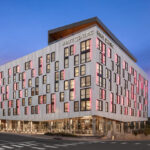East 9th Street in New York City, specifically the stretch in the East Village, holds layers of history beneath its modern facade. While today it’s a bustling thoroughfare, a look back reveals a fascinating past, particularly around the intersection with 4th Avenue. Once upon a time, this very street was home to an elaborate elevated walkway, a testament to the grandeur of a bygone era of retail.
Known as “The Bridge of Progress,” this sky bridge dramatically altered the landscape of East 9th Street between Broadway and 4th Avenue. As the “then and now” images illustrate, this ornate structure connected the two buildings of Wanamaker’s Department Store. The main store resided on the north side of East 9th Street, while the annex building stood to the south. This photograph, capturing East 9th Street looking west from 4th Avenue, dates back to 1924, offering a glimpse into a vastly different streetscape.
The story of this architectural feature is intertwined with the rise of department stores in New York. The northern building connected by the bridge, located between East 9th and 10th Streets, was initially constructed in 1862 by A.T. Stewart, a pioneering figure in the department store industry. Later, in 1896, John Wanamaker of Philadelphia acquired the building, establishing his first New York Wanamaker’s department store at this location on East 9th Street. To expand his retail empire, Wanamaker constructed an annex building from 1903 to 1907. This annex, which still stands today and currently houses a Kmart, was subsequently linked to the main store via the now-vanished “Bridge of Progress,” creating a unique shopping experience right on East 9th Street, New York, NY. Interestingly, the annex building is located within the NoHo Historic District, a landmarked area, as detailed in the official NoHo Historic District report.
Wanamaker’s was not alone in shaping the retail landscape around East 9th Street and the broader 14th Street vicinity. The late 19th and early 20th centuries saw a concentration of prominent department stores in this area, including Macy’s original building on 14th Street, Lord & Taylor, B. Altman, and S. Klein. This district became known as the “Ladies’ Mile,” a shopping destination that stretched along Broadway and Sixth Avenue, with East 9th Street situated at its southern edge. Just as New York City’s theater district migrated uptown over time, so too did its retail heart. From downtown near City Hall, then to Union Square and the Ladies’ Mile, and finally to the 34th Street/Herald Square area, major retail outlets followed the city’s northward expansion and changing demographics.
By 1955, Wanamaker’s decided to sell its original northern store on East 9th Street. Tragically, before its planned demolition, a fire in 1956 severely damaged the building, effectively sealing its fate. In 1960, the Stewart House, a large residential building clad in white brick, was erected in its place. Today, the “Bridge of Progress” is only a memory, but the historical footprint of Wanamaker’s and the grand department store era remains a fascinating chapter in the history of East 9th Street, New York, NY.


 Wanamaker
Wanamaker
